Standing outside the Manassas Battlefield visitor’s center I began to photograph the open and lush countryside surrounding the battlefield monuments and the roads used for auto tours. It’s a new camera—a Canon SX40 HS—and I have fallen in love with it. It allows me to capture what I am truly seeing. The art seems to flow through it. As I was clicking shots of an old, weathered tree, cannons and a far-off barn, I could feel the wonder and awe of the place. It was gorgeous. I hadn’t taken such good pictures since my trip to Yellowstone a few years back.
When I got home and reviewed the pictures I felt accomplished. I am an amateur photographer, and I don’t want to overstate my expertise. But I am pleased with how things turn out every once in a while, like an amateur carpenter who happens to have built a quality piece of furniture. It may never end up in a museum, but the beauty is still there, intrinsic in the work.
As I reviewed the pictures I reflected on the day. It had been lovely, spent with family on an atypically humidity-free Virginia afternoon. The scenery had been quaint and expansive, possessing that Americana-like quality of rolling hills or heirloom quilts—simple and unending at the same time.
Then I second-guessed the pictures of the cannons I had taken. These were merely replicas of real cannons that had rolled on those grounds 150 years ago (2012 is the sesquicentennial of the Civil War, and Manassas was the first battle). This place of beauty, which I had so proudly captured in my photographs, was beautiful precisely because over 5,000 people had died in it. The soil must have been soaked with blood. There must have been hats and belts and limbs strewn in places. It must have been repulsive, black and ungodly. And because of that, the land had lain fallow and become a park, a place of beauty and easygoing Sunday afternoons.
Art and war are more intertwined than we often realize. War is the subject of so many tapestries that hang from castle walls. It fills the artwork of every major period in Western history, from the early Renaissance to Picasso’s “Guernica” to the art being produced in response to our current wars. War is the unifying theme in The Iliad and The Odyssey, foundations of Western literature. War permeates the Old Testament, and its violence continues into the New Testament in the form of crucifixion. War is the context of Erich Maria Remarque’s All Quiet on the Western Front and the horror Wilfred Owen sings about in “Dulce et Decorum Est.” War and fighting drove the songs of the protest movements of the 60s and 70s, and in some respects have been an undercurrent in independent and alternative music being produced today.
What then to make of photos that mix today’s beauty with history’s blood? What should we make of art that is birthed out of the loss of life, limb, brother, son? The nobility of war is superficial, and it quickly melts away into the constant of death.
Death is constant. In war the reality of death is intensified. Art, then, I would argue, is humanity’s response to sadness with joy, to darkness with light, to death with immortality, to borrow from The Glenstal Book of Prayer. Art reflects humanity’s desire for birth and resurrection. Art gives a moment, a glimpse, a passage, a poet’s line that for an instant can numb the pain and horror of war and death. Art is not mere entertainment—it does not seek to remove our gaze or make us forget. Art pushes us beyond the event into present reality and an unknown future. It is not a painkiller or salve—what art does is remember and reflect so that we may see beauty arise again out of the blood and cinders of war.



